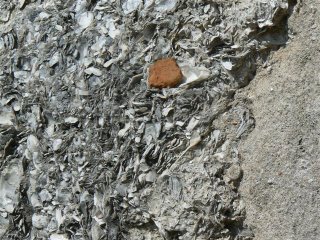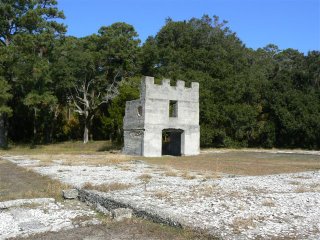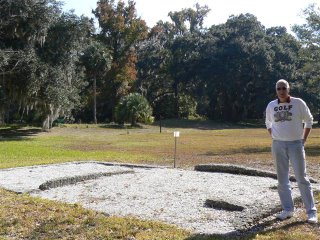Our next side trip was over to Sea Island to see the famous resort the Cloisters, but the entrance is guarded and there's no pullover to be able to take photographs. Oh well.
Finally we drove up to explore Fort Frederica which was established in 1736 to protect against the Spanish who had control of the area from St. Augustine southward. James Oglethorpe was named by King George II to lead colonies of what was called the "worthy poor" to build settlements in the area now called Georgia. The fort was built and then the village was laid out in the style of English village back home; wide streets laid out in neat grids. The town grew and prospered, but after Oglethorpe and his troops kept the Spanish at bay and the Spaniards eventually signed a truce with the British, the need for the troops disappeared and once the troops left the village slowly started to die.
The National Parks service works with the Glynn County school system in providing opportunities for school students to assist with archaeological "digs" on the grounds of Ft. Frederica to foster an interest in local history. Many artifacts are on display on the grounds near where they were originally discovered. There are no buildings here, but the archaeologists have worked out where a lot of the original buildings were thanks to a lot of written records they discovered and careful examination of the grounds of the fort. Thanks to the interpretive displays you can imagine what the village and fort looked like even though all that remains are the bare foundations. It's a fascinating glimpse into our history.

The magazine of Fort Frederica is the only part of the fort still standing. The barracks to the fort sat within the town.

A close up shot of the wall of the Ft. Frederica magazine. This is what tabby, which is a mixture of burned oyster shell, sand, lime and water looks like.
 The only part of the barracks left standing is the tower over the entrance. This barracks housed over a hundred soldiers.
The only part of the barracks left standing is the tower over the entrance. This barracks housed over a hundred soldiers. This Seville orange tree is one of many that the original settlers planted to cover the "domestic aromas" of the village. The town is long gone but the orange trees remain.
This Seville orange tree is one of many that the original settlers planted to cover the "domestic aromas" of the village. The town is long gone but the orange trees remain. I posed Denny by the foundation of what was once a two-story home. The lots were sixty by ninety feet in the village but notice the length and width of the house compared to Denny's 6' 6" height. The foundation appeared to be about 25' x 12'.
I posed Denny by the foundation of what was once a two-story home. The lots were sixty by ninety feet in the village but notice the length and width of the house compared to Denny's 6' 6" height. The foundation appeared to be about 25' x 12'.
These two boys were posing for their grandparents in uniforms supplied by the National Park Service. I couldn't resist snapping a shot myself.

This sculpture of a female right whale and her calf is near the St. Simon lighthouse & museum. The right whale is the only whale native to the waters of Georgia and is the state marine mammal. Unfortunately, they are near extinction due to run-ins with boats and ships.

The St. Simon lighthouse and lighthouse keeper's house are the oldest brick structures in Glynn County, Georgia. The refurbished lighthouse keeper's house is now a museum and fee to enter is $6 for adults.
2 comments:
Technically, the right whale is near extinction due to overzealous whalers. The name "right whale" comes from the fact that they were ideal for whalers; they're slow, they tend to stay near shore, and float when killed. Hence they were the "right" whale to kill when trying to get oil.
(Daily dose of nerdiness complete.)
Technically you are correct. But the biggest danger to those 300+ right whales remaining is boat traffic, especially to the whales that come to the waters around St. Simon's Island to give birth every year.
Post a Comment